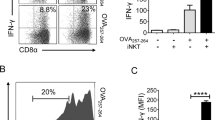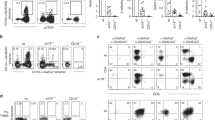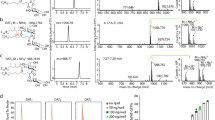Abstract
Invariant natural killer T cells (iNKT cells) have a prominent role during infection and other inflammatory processes, and these cells can be activated through their T cell antigen receptors by microbial lipid antigens. However, increasing evidence shows that they are also activated in situations in which foreign lipid antigens would not be present, which suggests a role for lipid self antigen. We found that an abundant endogenous lipid, β-D-glucopyranosylceramide (β-GlcCer), was a potent iNKT cell self antigen in mouse and human and that its activity depended on the composition of the N-acyl chain. Furthermore, β-GlcCer accumulated during infection and in response to Toll-like receptor agonists, contributing to iNKT cell activation. Thus, we propose that recognition of β-GlcCer by the invariant T cell antigen receptor translates innate danger signals into iNKT cell activation.
This is a preview of subscription content, access via your institution
Access options
Subscribe to this journal
Receive 12 print issues and online access
$209.00 per year
only $17.42 per issue
Buy this article
- Purchase on Springer Link
- Instant access to full article PDF
Prices may be subject to local taxes which are calculated during checkout








Similar content being viewed by others

References
Brigl, M. & Brenner, M.B. CD1: antigen presentation and T cell function. Annu. Rev. Immunol. 22, 817–890 (2004).
Godfrey, D.I. & Kronenberg, M. Going both ways: immune regulation via CD1d-dependent NKT cells. J. Clin. Invest. 114, 1379–1388 (2004).
Kawano, T. et al. CD1d-restricted and TCR-mediated activation of vα14 NKT cells by glycosylceramides. Science 278, 1626–1629 (1997).
Kinjo, Y. et al. Natural killer T cells recognize diacylglycerol antigens from pathogenic bacteria. Nat. Immunol. 7, 978–986 (2006).
Kinjo, Y. et al. Recognition of bacterial glycosphingolipids by natural killer T cells. Nature 434, 520–525 (2005).
Mattner, J. et al. Exogenous and endogenous glycolipid antigens activate NKT cells during microbial infections. Nature 434, 525–529 (2005).
Brigl, M., Bry, L., Kent, S.C., Gumperz, J.E. & Brenner, M.B. Mechanism of CD1d-restricted natural killer T cell activation during microbial infection. Nat. Immunol. 4, 1230–1237 (2003).
Nagarajan, N.A. & Kronenberg, M. Invariant NKT cells amplify the innate immune response to lipopolysaccharide. J. Immunol. 178, 2706–2713 (2007).
Paget, C. et al. Activation of invariant NKT cells by toll-like receptor 9-stimulated dendritic cells requires type I interferon and charged glycosphingolipids. Immunity 27, 597–609 (2007).
Salio, M. et al. Modulation of human natural killer T cell ligands on TLR-mediated antigen-presenting cell activation. Proc. Natl. Acad. Sci. USA 104, 20490–20495 (2007).
Brigl, M. et al. Innate and cytokine-driven signals, rather than microbial antigens, dominate in natural killer T cell activation during microbial infection. J. Exp. Med. 208, 1163–1177 (2011).
Fox, L.M. et al. Recognition of lyso-phospholipids by human natural killer T lymphocytes. PLoS Biol. 7, e1000228 (2009).
Gumperz, J.E. et al. Murine CD1d-restricted T cell recognition of cellular lipids. Immunity 12, 211–221 (2000).
Zhou, D. et al. Lysosomal glycosphingolipid recognition by NKT cells. Science 306, 1786–1789 (2004).
Porubsky, S. et al. Normal development and function of invariant natural killer T cells in mice with isoglobotrihexosylceramide (iGb3) deficiency. Proc. Natl. Acad. Sci. USA 104, 5977–5982 (2007).
Gadola, S.D. et al. Impaired selection of invariant natural killer T cells in diverse mouse models of glycosphingolipid lysosomal storage diseases. J. Exp. Med. 203, 2293–2303 (2006).
Li, Y. et al. Immunologic glycosphingolipidomics and NKT cell development in mouse thymus. J. Proteome Res. 8, 2740–2751 (2009).
Speak, A.O. et al. Implications for invariant natural killer T cell ligands due to the restricted presence of isoglobotrihexosylceramide in mammals. Proc. Natl. Acad. Sci. USA 104, 5971–5976 (2007).
Christiansen, D. et al. Humans lack iGb3 due to the absence of functional iGb3-synthase: implications for NKT cell development and transplantation. PLoS Biol. 6, e172 (2008).
Stanic, A.K. et al. Defective presentation of the CD1d1-restricted natural Va14Ja18 NKT lymphocyte antigen caused by β-D-glucosylceramide synthase deficiency. Proc. Natl. Acad. Sci. USA 100, 1849–1854 (2003).
Muindi, K. et al. Activation state and intracellular trafficking contribute to the repertoire of endogenous glycosphingolipids presented by CD1d. Proc. Natl. Acad. Sci. USA 107, 3052–3057 (2010); erratum 107, 6118 (2010).
Hsu, F.F. & Turk, J. Structural determination of glycosphingolipids as lithiated adducts by electrospray ionization mass spectrometry using low-energy collisional-activated dissociation on a triple stage quadrupole instrument. J. Am. Soc. Mass Spectrom. 12, 61–79 (2001).
Wun, K.S. et al. A molecular basis for the exquisite CD1d-restricted antigen specificity and functional responses of natural killer T cells. Immunity 34, 327–339 (2011).
Yu, K.O. et al. Modulation of CD1d-restricted NKT cell responses by using N-acyl variants of α-galactosylceramides. Proc. Natl. Acad. Sci. USA 102, 3383–3388 (2005).
Pei, B. et al. Diverse endogenous antigens for mouse NKT cells: self-antigens that are not glycosphingolipids. J. Immunol. 186, 1348–1360 (2011).
Ortaldo, J.R. et al. Dissociation of NKT stimulation, cytokine induction, and NK activation in vivo by the use of distinct TCR-binding ceramides. J. Immunol. 172, 943–953 (2004).
Parekh, V.V. et al. Quantitative and qualitative differences in the in vivo response of NKT cells to distinct α- and β-anomeric glycolipids. J. Immunol. 173, 3693–3706 (2004).
Cardell, S. et al. CD1-restricted CD4+ T cells in major histocompatibility complex class II-deficient mice. J. Exp. Med. 182, 993–1004 (1995).
Mallevaey, T. et al. T cell receptor CDR2 β and CDR3 β loops collaborate functionally to shape the iNKT cell repertoire. Immunity 31, 60–71 (2009).
Wilson, M.T. et al. The response of natural killer T cells to glycolipid antigens is characterized by surface receptor down-modulation and expansion. Proc. Natl. Acad. Sci. USA 100, 10913–10918 (2003).
Brigl, M. et al. Conserved and heterogeneous lipid antigen specificities of CD1d-restricted NKT cell receptors. J. Immunol. 176, 3625–3634 (2006).
Matulis, G. et al. Innate-like control of human iNKT cell autoreactivity via the hypervariable CDR3β loop. PLoS Biol. 8, e1000402 (2010).
Gapin, L. iNKT cell autoreactivity: what is 'self' and how is it recognized? Nat. Rev. Immunol. 10, 272–277 (2010).
Prigozy, T.I. et al. Glycolipid antigen processing for presentation by CD1d molecules. Science 291, 664–667 (2001).
Amit, I. et al. Unbiased reconstruction of a mammalian transcriptional network mediating pathogen responses. Science 326, 257–263 (2009).
Kawakami, K. et al. Critical role of Vα14+ natural killer T cells in the innate phase of host protection against Streptococcus pneumoniae infection. Eur. J. Immunol. 33, 3322–3330 (2003).
Im, J.S. et al. Kinetics and cellular site of glycolipid loading control the outcome of natural killer T cell activation. Immunity 30, 888–898 (2009).
Borg, N.A. et al. CD1d-lipid-antigen recognition by the semi-invariant NKT T-cell receptor. Nature 448, 44–49 (2007).
Pellicci, D.G. et al. Recognition of β-linked self glycolipids mediated by natural killer T cell antigen receptors. Nat. Immunol. 12, 827–833 (2011).
Yu, E.D., Girardi, E., Wang, J. & Zajonc, D.M. Cutting edge: structural basis for the recognition of β-linked glycolipid antigens by invariant NKT cells. J. Immunol. 187, 2079–2083 (2011).
O'Konek, J.J. et al. Mouse and human iNKT cell agonist β-mannosylceramide reveals a distinct mechanism of tumor immunity. J. Clin. Invest. 121, 683–694 (2011).
Cox, D. et al. Determination of cellular lipids bound to human CD1d molecules. PLoS ONE 4, e5325 (2009).
Yuan, W., Kang, S.J., Evans, J.E. & Cresswell, P. Natural lipid ligands associated with human CD1d targeted to different subcellular compartments. J. Immunol. 182, 4784–4791 (2009).
Ilan, Y. α versus β: are we on the way to resolve the mystery as to which is the endogenous ligand for natural killer T cells? Clin. Exp. Immunol. 158, 300–307 (2009).
Memon, R.A. et al. Regulation of sphingolipid and glycosphingolipid metabolism in extrahepatic tissues by endotoxin. J. Lipid Res. 42, 452–459 (2001).
Lantz, O. & Bendelac, A. An invariant T cell receptor α chain is used by a unique subset of major histocompatibility complex class I-specific CD4+ and CD4–8− T cells in mice and humans. J. Exp. Med. 180, 1097–1106 (1994).
Chiba, A. et al. Rapid and reliable generation of invariant natural killer T-cell lines in vitro. Immunology 128, 324–333 (2009).
Exley, M. et al. CD1d structure and regulation on human thymocytes, peripheral blood T cells, B cells and monocytes. Immunology 100, 37–47 (2000).
Veerapen, N. et al. Synthesis and biological activity of α-galactosyl ceramide KRN7000 and galactosyl (α1→2) galactosyl ceramide. Bioorg. Med. Chem. Lett. 19, 4288–4291 (2009).
Tatituri, R.V. et al. Inactivation of Corynebacterium glutamicum NCgl0452 and the role of MgtA in the biosynthesis of a novel mannosylated glycolipid involved in lipomannan biosynthesis. J. Biol. Chem. 282, 4561–4572 (2007).
Acknowledgements
We thank M. Exley (Beth Israel Deaconess Medical Center) for Cd1d−/− mice on a C57BL/6 background; K. Kawakami (Tohoku University) for S. pneumoniae (stain URF918); H. Kim for assistance with flow cytometry; and the tetramer facility of the US National Institutes of Health for ongoing support. Supported by the US National Institutes of Health (R01AI063428; T32AI007306 to P.J.B.; T32HL007633 to E.Y.K.; K08AI077795 to M.B.; P41-RR00954, P30-DK56341 and P60-DK20579 to F.-F.H.; and P41-RR05351 (Research Resource for Integrated Glycotechnology) to P. Azadi at the Complex Carbohydrate Research Center for nuclear magnetic resonance spectroscopy analysis), the Higher Education Funding Council for England (S.D.G. and J.P.S.), J. Bardrick (G.S.B.), the Royal Society (G.S.B.), the Medical Research Council (G.S.B.) and The Wellcome Trust (084923/B/08/Z to G.S.B.).
Author information
Authors and Affiliations
Contributions
P.J.B. and R.V.V.T. conceived of, did and interpreted data from the experiments; P.J.B. was the main author of the manuscript; M.B., A.T., F.-F.H., J.P.S., S.D.G. and E.Y.K. assisted with the experimental design and data interpretation, did experiments and edited the manuscript; G.S.B. assisted with the design of the experiments and synthesized key materials; and M.B.B. assisted with the design of the experiments and data interpretation, supervised the research and substantially contributed to the manuscript.
Corresponding authors
Ethics declarations
Competing interests
The authors declare no competing financial interests.
Supplementary information
Supplementary Text and Figures
Supplementary Figures 1–15 and Table 1 and Methods (PDF 2963 kb)
Rights and permissions
About this article
Cite this article
Brennan, P., Tatituri, R., Brigl, M. et al. Invariant natural killer T cells recognize lipid self antigen induced by microbial danger signals. Nat Immunol 12, 1202–1211 (2011). https://doi.org/10.1038/ni.2143
Received:
Accepted:
Published:
Issue Date:
DOI: https://doi.org/10.1038/ni.2143
This article is cited by
-
Unravelling the structural complexity of glycolipids with cryogenic infrared spectroscopy
Nature Communications (2021)
-
Glycosphingolipids and neuroinflammation in Parkinson’s disease
Molecular Neurodegeneration (2020)
-
Diversity in medullary thymic epithelial cells controls the activity and availability of iNKT cells
Nature Communications (2020)
-
Invariant NKT cells facilitate cytotoxic T-cell activation via direct recognition of CD1d on T cells
Experimental & Molecular Medicine (2019)
-
Regulation of the terminal maturation of iNKT cells by mediator complex subunit 23
Nature Communications (2018)


